|
|
|
Sort Order |
|
|
|
Items / Page
|
|
|
|
|
|
|
| Srl | Item |
| 1 |
ID:
137223
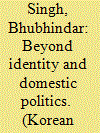

|
|
|
|
|
| Summary/Abstract |
South Korea and Japan have experienced their worst deterioration of bilateral relations since 2012. What are the long-term prospects for this relationship? Will it continue on this negative trajectory or recover positively in the long term? Challenging the conventional view that supports the former conclusion, this paper argues for a positive outlook for the relationship in the long term. This is defended from a structural perspective relying on two long-term strategic trends for Northeast/ East Asia—the elevated uncertainty in the regional environment (due to North Korea and China’s strategic rise); and the rising strain on the U.S. military presence in both countries. In response to these structural pressures, South Korea and Japan will adapt and adopt strategies to defend their national security within a reformed U.S. alliance structure and strengthen strategic cooperation through bilateral and trilateral (with the United States) means.
|
|
|
|
|
|
|
|
|
|
|
|
|
|
|
|
| 2 |
ID:
174787


|
|
|
|
|
| Summary/Abstract |
This article challenges the simplistic view that U.S. leadership in East Asia is weakening relative to China’s increasing ability to shape the regional order, which will force other states to choose between these two powers. Based on interviews with political elites, analysts, and academics in the United States, China, Japan, and Indonesia, we argue that the East Asian order transition is more complex and nuanced, especially when we examine views toward: (1) the Sino–U.S. rivalry for regional leadership; (2) whether Chinese initiatives such as the Asian Infrastructure Investment Bank and the Belt and Road Initiative disrupt the current order; and (3) the preferred vision of regional order for each of the four countries. While there is hardly a consensus view about issues of regional order, it appears that in the short to medium term, China is not expected to substantially overhaul the existing East Asian order. Nevertheless, Beijing is likely to chip away at U.S. regional leadership and, in the long term, would presumably seek to create an order that would sustain its rise and maintain its regional preponderance. The responses of other regional stakeholders toward these developments would be vital in shaping the collective impact on the East Asian order.
|
|
|
|
|
|
|
|
|
|
|
|
|
|
|
|
| 3 |
ID:
098438
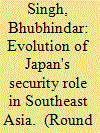

|
|
|
|
|
| Publication |
2010.
|
| Summary/Abstract |
This paper traces the evolution of Japan-Southeast Asia security relations over the Cold War and the post-Cold War periods. It makes two main points. First, Japan's relationship with Southeast Asia is slowly overcoming its traditional aversion of security affairs in defining its relations with Southeast Asia in the post-Cold War period. Japan has moved beyond economics to gradually carve out a more proactive role in the security affairs of Southeast Asia in the areas of multilateral security dialogues, peacekeeping missions, disaster relief provision, combating piracy, and others. Second, Southeast Asian states have become more amenable to Japan assuming a security role in the region. Not only have the new security roles contributed to enhanced trust and confidence between Japan and Southeast Asia, but Japan has also achieved the status of being a core security actor in Southeast Asian affairs. This role will continue to flourish in the post-Cold War period.
|
|
|
|
|
|
|
|
|
|
|
|
|
|
|
|
| 4 |
ID:
116366


|
|
|
|
|
| Publication |
2012.
|
| Summary/Abstract |
Defense diplomacy is a relatively new phenomenon aimed at addressing the strategic complexity and uncertainty of the post-Cold War world. It has hitherto received little analytical attention where defense relations in Southeast Asia are concerned. Our article seeks to redress that lack. Borrowing from historical and contemporary debates on diplomacy, we offer a working definition of defense diplomacy that distinguishes its pragmatic and transformative aspects. Building on the four articles that follow, we suggest that bilateral and multilateral engagements in defense diplomacy by Asian countries have primarily been pragmatic in form and function, aimed at maintaining peaceful and stable regional relations. Our modest contribution is hopefully a useful start to what could in time become a meaningful debate and cumulative knowledge on defense diplomacy.
|
|
|
|
|
|
|
|
|
|
|
|
|
|
|
|
| 5 |
ID:
188201
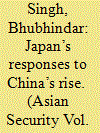

|
|
|
|
|
| Summary/Abstract |
Japan’s threat perceptions toward China have hardened over the post-Cold War period. This led Tokyo to rely more on overt balancing strategies compared with engagement and hedging strategies. While hard balancing measures are widely discussed in the literature, little or no attention is paid to soft balancing. Though concerned about China’s strategic rise, Japan’s strategic options are limited by the entrenched normative constraints within the security policymaking structure. These conditions make soft balancing a critical and viable strategy for Japan. The prominence of soft balancing is illustrated by analyzing Japan’s response to China’s widening influence in Southeast Asia, primarily focusing on two areas – East Asian multilateralism and the South China Sea territorial disputes. Empirically, this paper offers a more nuanced analysis of Japan’s response to China’s strategic rise; and theoretically, explains the way Japan’s case strengthens the conceptual utility of soft balancing through the incorporation of a normative perspective.
|
|
|
|
|
|
|
|
|
|
|
|
|
|
|
|
| 6 |
ID:
106466
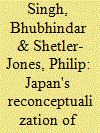

|
|
|
|
|
| Publication |
2011.
|
| Summary/Abstract |
Japan has steadily extended its military reach from a domestic zone of defense against territorial invasion in the late 1950s, through regional security policy in the late 1970s to what has now become a globally scaled military role. This re-expansion is perceived by some as evidence of revived militaristic ambitions, and by others as subservience to the US global strategy. However, taking the cue from Japan's 2004 National Defence Programme Guideline (New Taiko), this paper assesses the role globalization has played in this territorial expansion. The impact of globalization is evident in the double expansion of Japan's national security conception in geographical terms and self-defense forces roles in global security. These 'expansions' are studied through two key elements of globalization - the deterritorialization of complex relations of interdependence between states (security globality) and the inter-penetrating nature of these relations blur the boundary between foreign and domestic spaces (intermestic space).
|
|
|
|
|
|
|
|
|
|
|
|
|
|
|
|
| 7 |
ID:
082781
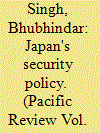

|
|
|
|
|
| Publication |
2008.
|
| Summary/Abstract |
The paper argues that a significant change in Japanese post-Cold War security policy has occurred, as compared to its Cold War security policy. Instead of relying solely on power-based realist variables, this paper argues that a significant change is taking place because of the shift in Japan's security identity from a 'peace state' to an 'international state'. What this refers to is that Japan sees itself as playing a more active role in military-strategic affairs in the post-Cold War period due to the normative structure shift within Japan in relation to the practices and role(s) in the regional and international security environment. To show change in Japan's security identity and its resultant security behaviour, norms in three areas that define and shape its security policy are contrasted - Japan's definition of national security; its contribution, in military terms, to regional and international security affairs; and the level of agency (control) Japan has in its security policy. The international-state security identity is increasingly recognised by the members of Japan's security policy-making elite and is used to formulate Japan's security policy in the post-Cold War period. It is also gradually being accepted by the larger Japanese society and has become a permanent feature of Japan's security discourse
|
|
|
|
|
|
|
|
|
|
|
|
|
|
|
|
| 8 |
ID:
187398
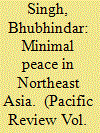

|
|
|
|
|
| Summary/Abstract |
Northeast Asia is usually associated with conflict and war. Challenging this prevailing view, this article shows that the sub-region has achieved minimal peace since its peaceful transition from the Cold War to the post-Cold War period. The questions posed are: (a) what factors are responsible for Northeast Asia’s minimal peace?; and (b) how will these factors respond to the worsening US-China competition since 2010? This article’s argument is two-fold. First, Northeast Asia’s minimal peace is explained by three realist-liberal factors: America’s hegemony; strong economic interdependence among the Northeast Asian states; and a stable institutional structure in East Asia, including Northeast Asia. These factors kept a stable balance of power, ensured development and prosperity, and mitigated the political and strategic tensions between the states. Second, Northeast Asia’s minimal peace would be durable to counter the negative effects of the Sino-US competition in the coming decades. While the economic interdependence and institutional building factors have shown resilience, the US hegemony faces a robust challenge from China. Nevertheless, the US hegemony is durable because of America’s enduring relative strategic and economic advantages over China, the expanded role of America’s regional allies to preserve US preponderance and China’s problems in building an alternative regional order.
|
|
|
|
|
|
|
|
|
|
|
|
|
|
|
|
| 9 |
ID:
107607
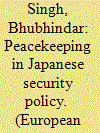

|
|
|
|
|
| Publication |
2011.
|
| Summary/Abstract |
This article analyses how peacekeeping became available to Japan as a policy option during the early 1990s and, thereafter, a part of the national security discourse through the international-domestic contexts interaction approach. The international context refers to the nature (culture) of the international environment at a particular period of time defined by the dominant norms that govern inter-state relations. It also highlights the policy options available to states. The domestic context refers to the nature of the leadership within a state that interprets the international norms and incorporates them into the domestic agenda. Japan's implementation of the peacekeeping policy was a result of the collective security norms that defined the international environment during the early 1990s and the re-emergence of the revisionists within the Japanese political system - a group that embraced the collective security norms and pushed for the peacekeeping policy in the hope of expanding Japanese security policy in the post-Cold War period.
|
|
|
|
|
|
|
|
|
|
|
|
|
|
|
|
| 10 |
ID:
151992


|
|
|
|
|
| Summary/Abstract |
One of the biggest challenges for the East Asian region today is the Sino-Japanese relationship. Starting with the fishing trawler incident in September 2010, followed by Japan's nationalisation of the Senkaku/Diaoyu Islands, this relationship is experiencing an escalation of tensions in most, if not all, areas of the bilateral relationship. In response to the intensifying competition, China and Japan have elevated the importance of South-East Asia and the Association of Southeast Asian Nations (ASEAN) in their foreign policy strategies. Focusing on how elites from five South-East Asian states—Indonesia, Malaysia, the Philippines, Singapore and Vietnam—perceive the engagement of China and Japan with the region, this article poses two questions: (1) How do South-East Asian elites view the Sino-Japanese competition? and (2) How do South-East Asian elites view the role of ASEAN in managing the competition? The analysis here concludes that while some South-East Asian elites see opportunities in the Sino-Japanese competition, they nevertheless do not perceive it as an issue of critical significance. Instead, the concern lies generally with major-power dynamics, and particularly with Sino-US relations. ASEAN is viewed to lack the ability to manage the negative consequences of the Sino-Japanese competition, although its external balancing function has perceptibly helped to restrain any escalation of major-power tensions.
|
|
|
|
|
|
|
|
|
|
|
|
|
|
|
|
| 11 |
ID:
145688
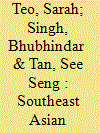

|
|
|
|
|
| Summary/Abstract |
Perspectives from Indonesia, Malaysia, the Philippines, Singapore and Vietnam show that South Korea’s middle power role in Southeast Asia is confined to economics and capacity building. Despite being absent from Southeast Asia’s geostrategic calculus, Korea’s non-revisionist inclination is seen to be advantageous in its pursuit of enhanced middle power status.
|
|
|
|
|
|
|
|
|
|
|
|
|
|
|
|
| 12 |
ID:
187395
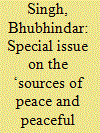

|
|
|
|
|
| Summary/Abstract |
East Asia is usually associated with war and conflict. This applies to its historical past, as well as to the present post-Cold War period. In fact, this pessimism on the region has hardened with the worsening structural US-China competition since 2010. Challenging this prevailing view, this special issue argues that the concepts of peace and peaceful change are critical elements to explain East Asian regional dynamics in the post-Cold War period. It poses the following questions: (a) how could peace and peaceful change be analysed conceptually at the regional level?; (b) what type of peace and peaceful change notions are applicable to East Asia?; (c) what are the sources and mechanisms of regional peace in East Asia and its sub-regions and how have the sources and mechanisms changed over the post-Cold War period?; (d) how has the worsening US-China structural competition affected the prospects of peace in East Asia?; and (e) how do the middle powers, namely Japan, South Korea, Australia and Indonesia, contribute to peace and peaceful change in the region? The special issue is the first attempt to systematically apply the concepts of peace and peaceful change on East Asia. The articles identify the sources and mechanisms of peace and peaceful change, apply an eclectic conceptual approach that combines traditional and non-traditional IR theories; and assess the prospects of peace in East Asia in the context of the worsening structural tensions presented by the US-China competition.
|
|
|
|
|
|
|
|
|
|
|
|
|
|
|
|
|
|
|
|
|